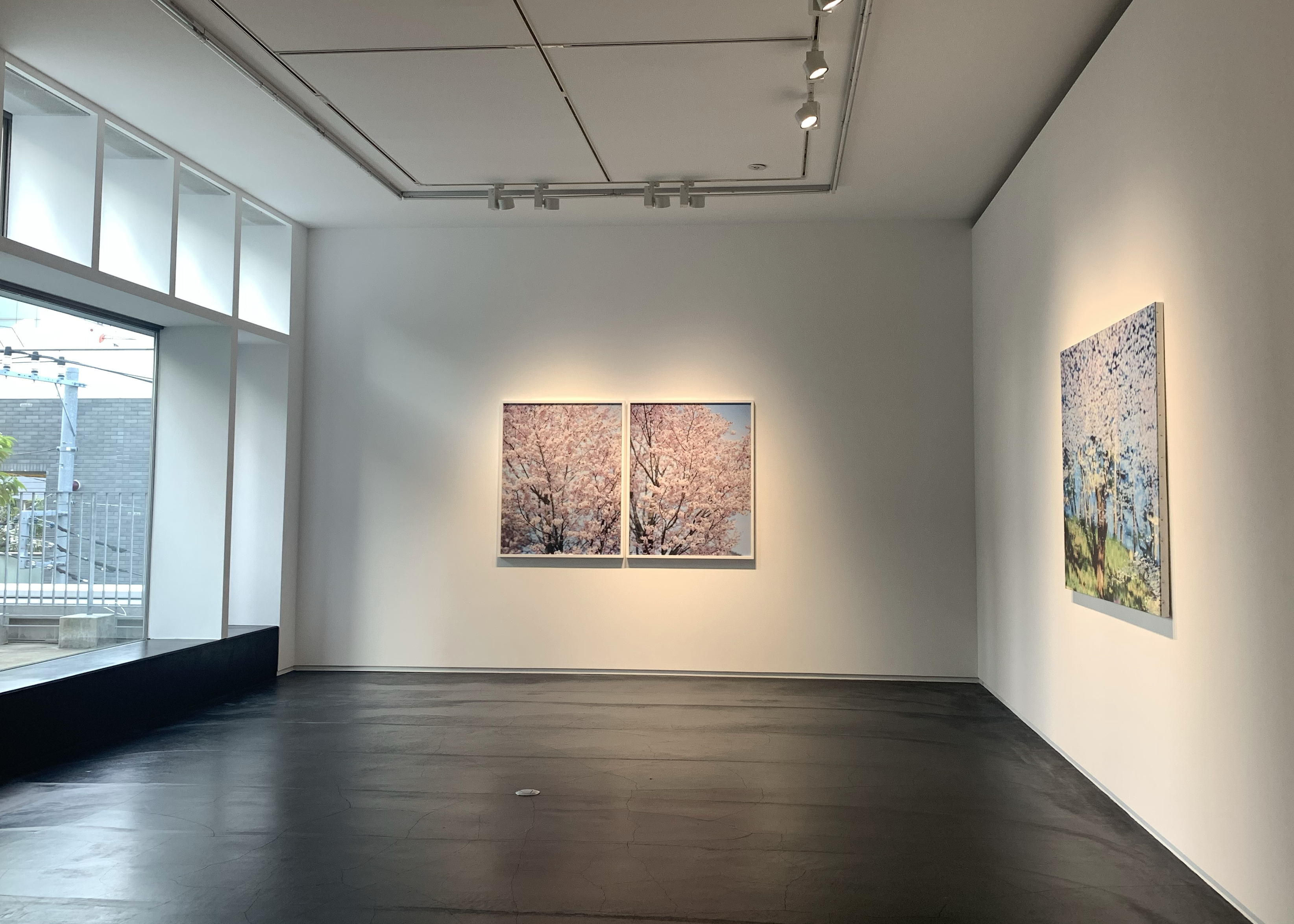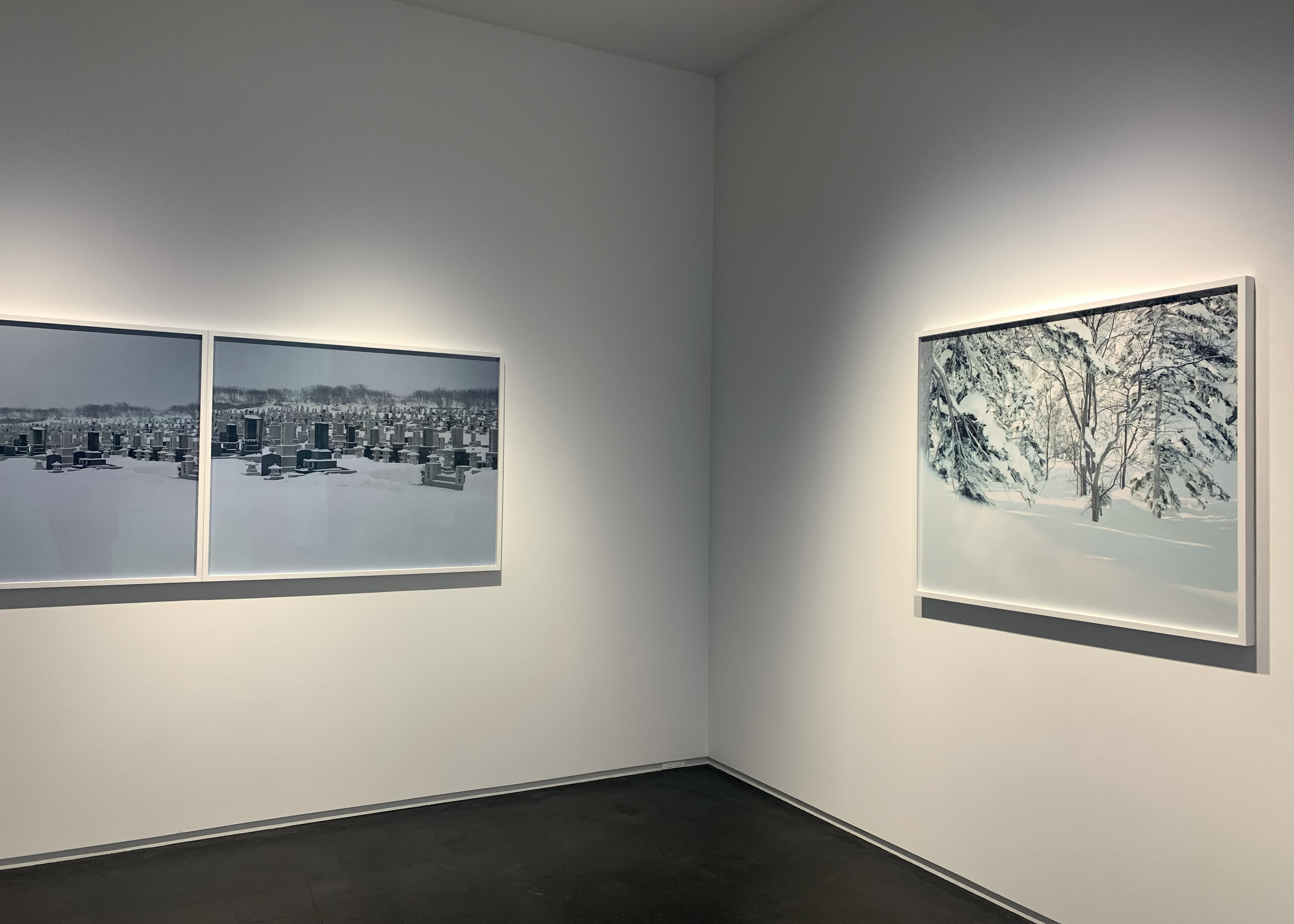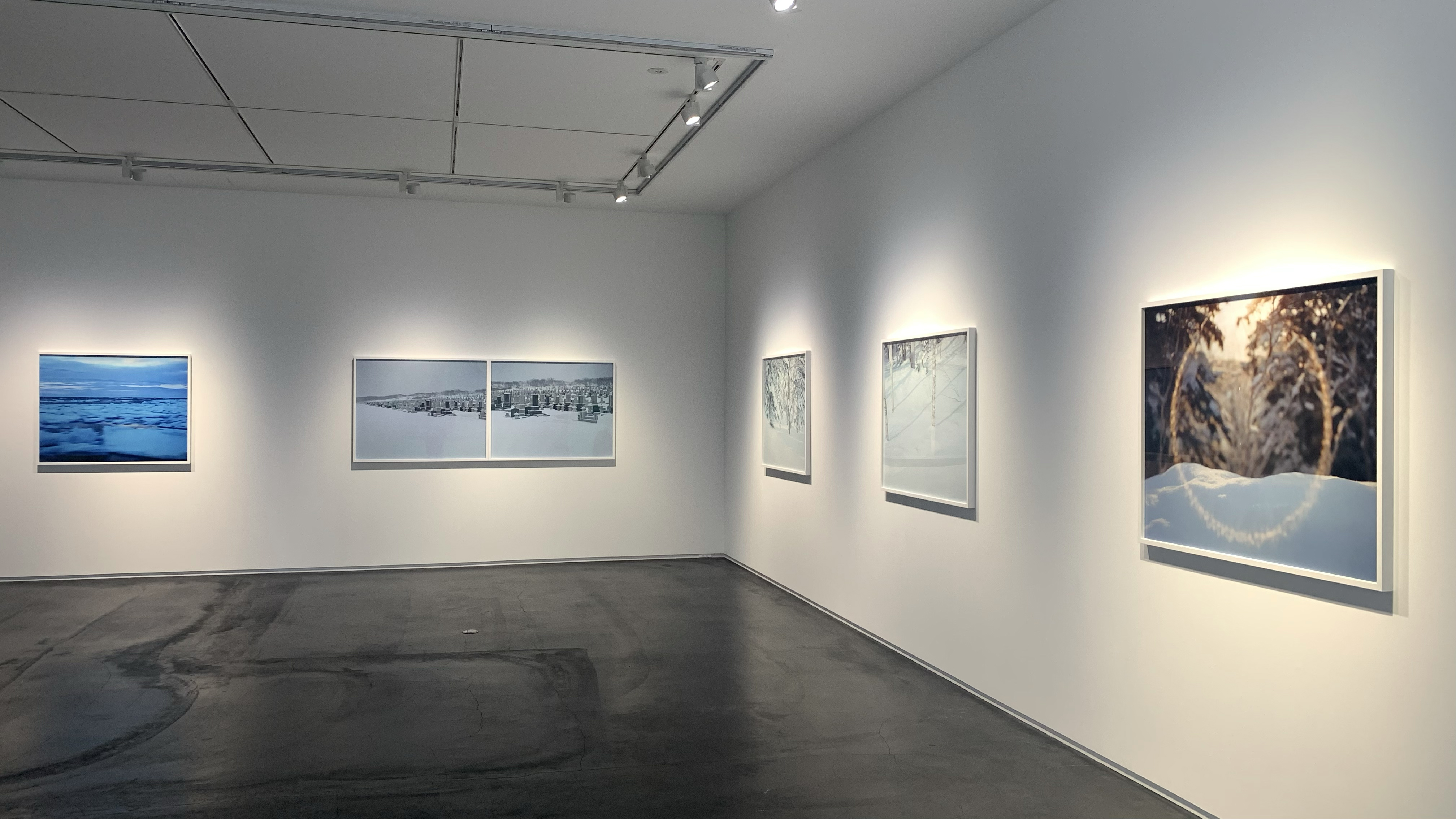コラム
落合憲弘
John Sypal
タカザワケンジ
なぎら健壱

Risaku Suzuki “SAKURA 21, 4-597, 4-598”, 2021, Chromogenic print, 1190 × 952 mm (each)
© Risaku Suzuki Courtesy of Taka Ishii Gallery
Occupying the third floor of complex665 in Roppongi, Taki Ishii Gallery is a cavernous L-shaped room with cool grey floors and a high ceiling. This large, quiet venue- with a floor to ceiling window that looks out towards Roppongi’s skyscrapers- provides a fitting environment for Risaku Suzuki’s latest show, “Winter to Spring”.
Like the gallery’s vast white walls, the show’s practical title does all it has to- namely, provide an clean open surface on which to contemplate the images. There’s nothing to get in the way here- and with such gorgeous chromogenic prints at these dimensions (1190 x 952), I don’t think anything really could.
Visitors are presented first with an ice floe atop vast, dark water in a moment of blue during that magic hour as the sun sets. Next, a snowy cemetery stretches into the distance under an overcast sky across the greater part of two large prints. Due to the way the two frames touch side by side, it’s possible to view these massive prints as a panorama. However, one quickly notices that while they don’t quite line up “correctly”, it still makes a complete image in your mind. This slight “gap” in the work isn’t the last.
After leaving the cemetery, the sun appears, tonally flattening out the snow like a thick freshly-washed down blanket. This field of white gives way to spring, here announced in a trumpet-like halo-blast of sunlight. And there, at the other end of the room, facing the cold graveyard in the distance, hangs another enormous diptych: two slightly different views of the same spectacular cherry tree basking in full bloom.
Certainly, there isn’t anything subtle in this Death / Life motif— indeed, frozen, overcast tombstones could not be anything further from the staggeringly vivid, near-unbelievably detailed images of Suzuki’s cherry tree at the height of its glory. These two photos of this tree- (and I’d like to use glorious again) this glorious piece- rightly kept on its own wall- is a counter-image to winter and promise of the spring to come. At the same time, it echoes death. This being Japan, sakura are felt to be at their most bittersweetly beautiful as the petals fall. In Suzuki’s images, the blossoms are kept frozen in time. This tree will eternally, unnaturally, photographically remain in bloom, each petal in its place. Transience is implied through its absence- any petals that flutter down do so in our minds.
In his statement for his show, Suzuki notes,
Photographs, like words, are fragmentary, entrusting the viewer to perceive the scenes that remain unseen in the midst of one photograph to the next.
Be they spatial (a shift in camera position), or temporal (the time elapsed between exposures, or withholding them all together), Suzuki has long explored such juxtapositions, entrusting the viewer to perceive what that “unseen” thing might be between his pictures. Life is kind of like that. Our daily worlds are full of disjointed moments and half-glances that we plod through. How close do we really look at things in our daily lives? There’s a lot of gaps out there. In the clarity and beauty of Suzuki’s images- and in the gaps in between them- we are given room to think about how it feels to look at something. Once you start to really look at something, you’re able to start to really feel something.

六本木の「コンプレックス665」の3階にあるタカ・イシイギャラリーは、クールなグレーの床と高い天井を持つ洞窟のようなL字型の空間です。床から天井まで広がる窓からは六本木の高層ビル群が一望でき、広く静かな空間は、鈴木理策の最新作「冬から春へ」の展示にふさわしい環境といえるでしょう。
ギャラリーの広大な白い壁のように、この展覧会のタイトルは、イメージを熟考するためのクリーンなオープンサーフェスを提供しているかのようです。1190mm×952mmという大きく豪華なカラープリントにとって、邪魔になるものは何もありません。

日没後のマジックアワーに広大で暗い水面に浮かぶ流氷。 次に、曇り空の下、雪に覆われた墓地が2枚の大きなプリントの大部分を占めています。
2つのフレームが隣り合っているため、この巨大なプリントはパノラマとしても見ることができます。この2枚は「正しく」並んでいるわけではないのですが、それでも頭の中では1つのイメージとして完結していることにすぐ気がつきます。このわずかな 「ずれ」が、この作品の最後ではない。

墓地のプリントの次に太陽が現れ、洗いたての厚い毛布のように雪を平らにしていきます。この白の野原は、春へと向かうのです。ラッパのような、後光のような、陽光。
そして冷たい墓地に面したもう壁には、もうひとつの巨大な二枚組の写真が掛けられています。

写されたモチーフに対して、死と生という繊細さはないように感じられます。実際、凍てついた曇天の墓石に対して、鈴木さんが写す絶頂期の桜は驚くほど鮮やかなのです。
この2枚の桜の写真は、あえて言うならばこの「栄光」の作品は、壁に飾られることこそがふさわしい、冬の対抗イメージであり、来るべき春への約束のようでもあります。そして同時に、死をも連想させています。
日本では、桜は散るときが最もほろ苦く美しいとされています。鈴木が写す桜の花は、時間の中で凍結されたままなのです。この樹は永遠に、不自然に、写真的に、花びらの一枚一枚がその場所に咲いています。花びらが舞い落ちるのは、私たちの心の中なのです。
鈴木は今回の個展のステートメントの中で、次のように語っています。
- 写真は言葉のように断片的で、写真と写真のあいだ、その見えない部分を見る人に託します。
空間的なもの(カメラ位置の移動)、時間的なもの(露光時間の経過、あるいは露光しない)、鈴木さんは写真の間にある「見えないもの」を見る人に託して、その並置を探ってきました。
人生も似たようなものです。私たちの日常は、バラバラの瞬間や半端な視線に満ちていて、それでいて慎ましく過ごしています。私たちは日常をどれだけ近くで見ているのでしょうか。 そこには、たくさんのギャップがあるのです。鈴木の写真の透明感や美しさ、そしてその隙間に、私たちは「何かを見るということを考える」余地を与えられているのです。 本当に見ることで、本当に感じることができると思います。

- 鈴木理策 「冬と春」
- 会期:2022年6月4日(土) – 7月2日(土)
- 会場:タカ・イシイギャラリー(complex665)
- 東京都港区六本木6-5-24 complex665 3F
- 12:00〜18:00(日曜・月曜・祝日定休)
 Vol.41 中嶋琉平|Ryuhei Nakashima「Asia, New York, and Tokyo」、高地二郎|Jiro Kochi「GINZA: Through the eye of a Salaryman 1950-1990」
2025/11/08
Vol.41 中嶋琉平|Ryuhei Nakashima「Asia, New York, and Tokyo」、高地二郎|Jiro Kochi「GINZA: Through the eye of a Salaryman 1950-1990」
2025/11/08
 Vol.40 藤岡亜弥|Aya Fujioka「Life Studies」、荒木塁|Lui Araki 「Color/Scape」
2025/10/03
Vol.40 藤岡亜弥|Aya Fujioka「Life Studies」、荒木塁|Lui Araki 「Color/Scape」
2025/10/03
 Vol.39 榎本八千代|Yachio Enomoto「家族写真 / Family Photo」
2025/09/05
Vol.39 榎本八千代|Yachio Enomoto「家族写真 / Family Photo」
2025/09/05


PCT Membersは、Photo & Culture, Tokyoのウェブ会員制度です。
ご登録いただくと、最新の記事更新情報・ニュースをメールマガジンでお届け、また会員限定の読者プレゼントなども実施します。
今後はさらにサービスの拡充をはかり、より魅力的でお得な内容をご提供していく予定です。
 「Photo & Culture, Tokyo」最新の更新情報や、ニュースなどをお届けメールマガジンのお届け
「Photo & Culture, Tokyo」最新の更新情報や、ニュースなどをお届けメールマガジンのお届け 書籍、写真グッズなど会員限定の読者プレゼントを実施会員限定プレゼント
書籍、写真グッズなど会員限定の読者プレゼントを実施会員限定プレゼント